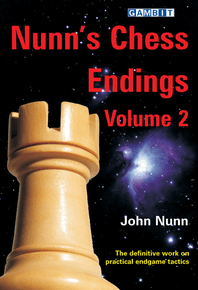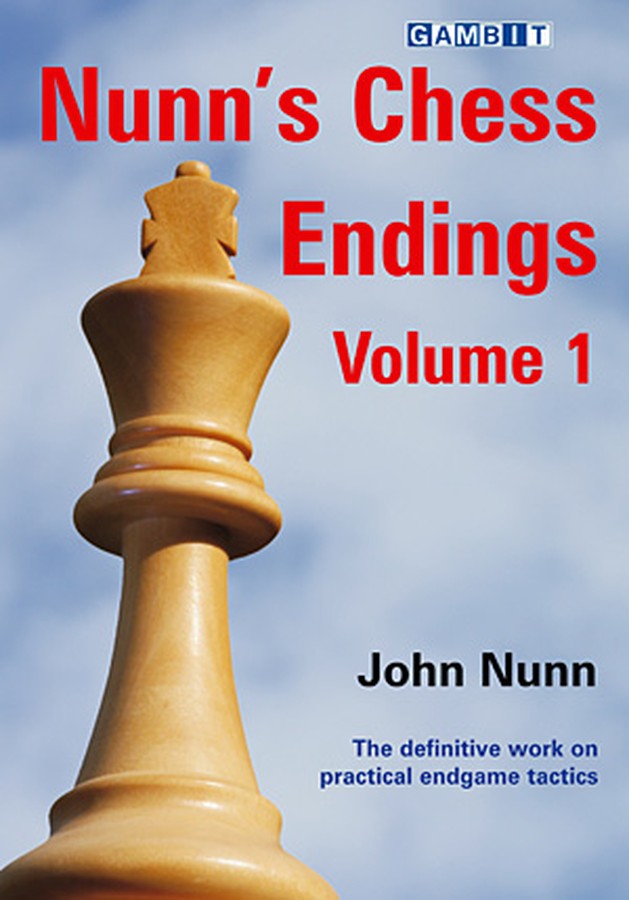| Nivå | C-D |
| Utgivelsesdato | Juni 2010 |
| Forfatter | |
| Pris | 265 NOK |
Nunn's Chess Endings Volume 1
Forventningene er store til John Nunns tobindsverk om sluttspill, og han ser ut til å oppfylle dem med nyskapende lærebøker i sluttspill for alle med rating omlag 1500 og oppover. Første bind handler om alle sluttspill UTEN tårn.
Nunn er ikke bare presis i analysene og påviser en rekke feil i tidligere bøker som finnes i markedet. Han satser ikke mindre på verbale forklaringer og oppsummeringer som er allmenngyldige og i ikke så liten grad verdifulle nyheter i så måte.
Åpenbart glimrende levert av den store sjakkforfatteren, sjakkpedagogen og sluttspillmesteren.
Frederic Friedels ferske anmeldelse av boka på www.chessbase.com:
Last year we reviewed John Nunn’s new endgame book Understanding Chess Endgames. That review explained how the author had decided to write a detailed endgame book, but soon ran into a problem: “The idea was," he wrote, "that an introductory chapter would give a brief survey of this ‘presumed knowledge’ so that I would not have to explain it in the main body of the book. However, it quickly became clear that this ‘introductory chapter’ would be more like a book in itself, so I put the main project to one side and started to think about how this introductory chapter could be turned into a useful book.”
The earlier book out of the way, John continued work on the main project, and now we have the first of two volumes of Nunn’s Chess Endings. The second volume, containing an even chunkier 352 pages, is scheduled to appear in the autumn. The two volumes are divided by material, with the first containing all endings without rooks and the second covering those with rooks.
The book starts with two introductory chapters, the first an introduction explaining the philosophy behind the book and the second an essay on the qualities required for successful endgame play. There are then 114 pages on pawn endings, 149 pages on minor-piece endings and 27 pages on queen endings.
Nunn explains right at the start that he is assuming readers possess a certain level of endgame knowledge (that which can be obtained by reading Understanding Chess Endgames or another book aimed at a similar level). He is therefore able to omit much elementary material in the present book, which allows him to start at a more advanced point and cover topics in a depth which is not normally possible. It follows that this book is not aimed at beginners, and readers should be of club standard or above to appreciate it.
Nunn’s Chess Endgames is not an encyclopaedia which covers the endgame on a case by case basis, but an instructional text which seeks to explain general unifying concepts which apply in many endgame situations. To be sure, some of these concepts apply mainly in one particular type of endgame (reserve tempi, for example, are usually only relevant in king and pawn endings), but there are linking threads which run through his treatment.
A book of a particular size can contain a large number of positions with shallow analysis or a smaller number of positions with detailed analysis. Nunn’s book definitely falls into the latter category, with each position being explored in great detail. He is at pains to explain the concepts in each example using words, but then goes on to back this up with concrete variations. As he points out in the introduction, it is easy to be seduced by a superficially convincing explanation which concrete analysis shows to be totally false.
Each chapter of the book is divided into a number of sections and subsections, with a summary at the end of each. This divides up the material into manageable chunks and a dedicated reader would probably go through one section each day. Nunn makes the point that theoretical examples are specifically designed to be clear-cut, with all the pieces optimally placed, but in actual play one often encounters difficulties which are rarely covered in theoretical works. His exclusive use of genuine practical examples allows him to present a more realistic view of many endgame themes.
Understanding Chess Endgames proved disappointing in only one respect: the lack of reciprocal zugzwangs. I am delighted to report that this is remedied in Nunn’s Chess Endgames. This is all the more surprising in that Nunn’s Chess Endgames contains only examples from practical play (over-the-board or correspondence) and includes no studies or composed positions. Nunn himself seemed surprised at the frequency with which such zugzwangs appear in ordinary positions and it may well be that he is correct when he hints that tactical ideas occur in the endgame more often than most players suspect – it’s just that they are often overlooked.
This reviewer is not equipped to comment on the accuracy of Nunn’s analysis, but the Doctor is generally regarded as an accurate analyst and I have no reason to suspect that this book does not match his usual standard. The contents of Nunn’s Chess Endgames are firmly aimed at improving the reader’s endgame play, and although one sometimes suspects that he would have liked to explore some more esoteric by-ways, in this book he remains focussed on purely practical instruction and advice.
Frederic Friedel
| Innbundet? | Nei |
| Type | Bok |
| Språk | Engelsk |
| Antall sider | 319 |
Se også
-

Nunn's Chess Endings Volume 2
KjøpAndre del av John Nunns nye sluttspillverk handler om alle sluttspill MED tårn på brettet. En praktisk og instruktiv ny bibel for alle spillere med rating fra omlag 1500 og oppover.
- Pris
- 265
- Nivå
- C-D
- Av
- Utgivelsesdato
- September 2010

